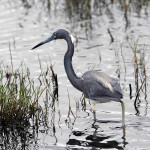• • •
Tri-colored Herons at a glance are similar to both the Great and Little Blue Heron, with long legs, a slender body and overall blue plumage. All forage for food among the shallows of wetland habitats. But the similarities end there.
• Length: 26 inches
• Wingspan: 36 inches
• Season: Year-round
More about Tri-colored Herons.
Where they are and when.
Tri-colored Herons live up to their name, with their blue coat accented by a white belly and strip down their throat and rufous plumage on both their neck and back. During breeding season, their extremely long bill – which looks too big for their body – turns blue with a dark tip, and they add a long white ribbon behind their heads.
They wade slowly in water up to their hips, stalking fish, frogs and insects and then pounce with their wings outstretched. Sometimes, they even hop and dance around like a Reddish Egret.
Tri-colored Herons nest in large colonies with other herons, building raised platform nests of sticks lined with other vegetation. They lay three to seven pale blue-green eggs. During courtship, they will fly in circles, chase their prospective mates, puff up their plumage and strike their bills together.






You must be logged in to post a comment.